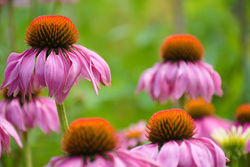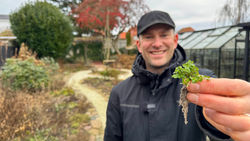How to divide Montbretia (Crocosmia): Step-by-step instructions
- Lars Wildes
- Sep 4, 2023
- 5 min read
Montbretia, scientifically known as Crocosmia, is a delightful addition to any garden. With its striking, fiery-colored flowers and sword-shaped leaves, it's no wonder many gardeners want to multiply this beauty.
One of the best ways to achieve this is by dividing Montbretia plants, specifically the corms (bulbs). In this step-by-step guide, tailored to beginner gardeners, we'll walk you through the process to make it even easier.
What You'll Need:
Garden spade or shovel — A sturdy garden fork or shovel will help you dig up the Montbretia corms.
Pruning shears — sharp shears for cutting foliage and roots.
Garden gloves — To protect your hands while handling the corms... these are optional.
Watering can — To water the newly divided corms.

Crocosmia (Montbretia)
Height: 24-36 inches (60-90 cm)
Spread: 12-18 inches (30-45 cm)
Sun Exposure: Full sun to partial shade
Soil Type: Well-draining, loamy soil with a pH of 6.0 to 7.0
Steps to dividing Crocosmia
Step 1: Divide in the spring or autumn
Divide Montbretia in the early spring when new growth begins, or in the fall after blooming but before the first frost.
Step 2: Prepare your tools Ensure your garden fork or shovel and pruning shears are clean and sharp.
Step 3: Prepare the site
Measure a circle around the Montbretia clump that's about 10-12 inches (25-30 cm) in diameter. This will be your digging area. Ensure it's at least 6 inches (15 cm) deep to accommodate the corms. You must dig these up. If you leave any behind, the perennial will return next year.
Pro tip: Water the Montbretia clump thoroughly the day before dividing. This will make it easier to lift and separate.
Step 4: Dig up the corms (the bulbs)
Insert the garden fork or shovel into the soil, about 6 inches (15 cm) away from the clump's outer edge.
Gently work your way around the clump, lifting it from different angles to avoid damaging the corms.
Carefully lift the entire clump from the ground.
Step 5: Divide the Corms
Use your pruning shears to cut the Montbretia corms into sections. Each section should have at least 1-2 healthy corms.
Ensure each section has healthy foliage attached. Trim back the foliage to about 4-6 inches (10-15 cm) in length.
Step 6: Replant the corms
Choose a sunny or partially shaded location in your garden or prepare pots.
Dig holes that are approximately 3-4 inches (7-10 cm) deep for each corm section.
Space the sections about 12-18 inches (30-45 cm) apart to allow for future growth.
Place each section into its hole and cover it with soil. Water thoroughly to settle the soil.
If you're planting in pots, keep them in a greenhouse or a shady area until you're ready to plant them out in the garden.
Step 7: Water and mulch
Water the newly planted Montbretia corms generously after planting.
Option: Apply a 2-3 inch (5-7.5 cm) layer of mulch around the plants to conserve moisture and suppress weeds.
Step 8: Maintenance
Continue to water the divided Montbretia corms regularly, especially during dry spells.
Fertilize with a balanced, slow-release fertilizer in the spring to encourage healthy growth.
Dividing Montbretia corms is a surefire way to propagate these gorgeous plants and ensure they continue to thrive in your garden. With these easy-to-follow steps, you can successfully divide Montbretia and enjoy their stunning blooms year after year. Happy gardening!
What Are corms?
If you're reading this far down the page, you've seen us talk about corms several times. Before you start dividing Montbretia corms, it's essential to understand what corms are and their role in plant growth.
Corms are specialized underground storage structures that serve as a source of energy and nutrients for certain types of plants. They are often mistaken for bulbs (and honestly, we call them here in our garden), but technically, they have distinct differences.
Characteristics of corms:
Shape: Corms are typically round or oval-shaped, resembling a small, solid bulb.
Texture: Unlike bulbs, which have layered scales, corms are solid and fleshy.
Growth: New corms develop on top of the old corm as the plant matures, forming a stack of corms. The new corms are located at the top, while the old corm withers away.
Role: Corms store nutrients and water, enabling the plant to survive adverse conditions and regrow when the environment is favorable.
Reproduction: Corms are a means of vegetative reproduction for many plants, allowing them to multiply and spread.
Montbretia (Crocosmia) plants grow from corms, which store the necessary resources for the plant's growth, including carbohydrates and moisture.
When you divide Montbretia, you are essentially separating these corms into smaller sections, each of which can grow into a new plant. Understanding the role and structure of corms is key to successfully dividing and propagating Montbretia in your garden.
Where is the best place to plant crocosmia?
Choosing the right location for planting Crocosmia (Montbretia) is important to ensure the health and vibrancy of these beautiful flowers. Crocosmia is a very versatile plant, but it thrives under specific conditions.
Here's what you need to consider when selecting the perfect spot for your Crocosmia:
Sunlight: Crocosmia loves sunlight. It performs best when planted in a location that receives at least 6-8 hours of direct sunlight per day. While they can tolerate partial shade, they may produce fewer blooms in shadier areas.
Soil Type: Crocosmia prefers well-draining soil that is rich in organic matter. Aim for a loamy soil with good drainage to prevent waterlogged roots, as they are susceptible to rot in excessively wet conditions. You can improve the soil by adding compost or organic matter before planting.
Soil pH: Crocosmia is adaptable but tends to do well in slightly acidic to neutral soil with a pH range of 6.0 to 7.0. You can test your soil's pH and adjust it if necessary to create the ideal growing environment.
Space: These plants can spread and multiply over time. When planting Crocosmia, provide enough space between individual plants to accommodate their growth. A spacing of 12-18 inches (30-45 cm) between each plant is generally recommended to allow for proper air circulation and prevent overcrowding.
Climate: Crocosmia is suitable for USDA hardiness zones 6 to 10, making it adaptable to a wide range of climates. However, they tend to thrive in areas with mild winters and moderate rainfall. Here in our garden in Denmark, we're zone 8a.
Wind Protection: While Crocosmia can tolerate some wind, strong winds can damage their tall flower stalks. If your garden is in a windy area, consider planting them near a windbreak or using stakes to support the plants.
Aesthetics: Crocosmia's vibrant and eye-catching blooms make it an excellent choice for borders, mixed flower beds, or as a focal point in your garden. Consider their height and color when planning your garden design to create a visually appealing landscape.
By carefully selecting the right location based on these considerations, you can ensure that your Crocosmia plants thrive and reward you with their stunning display of colorful flowers year after year.





